Mechanical Characterization of Sintered Silver Materials for Power Device Packaging: A Review
Abstract
:1. Introduction
2. Sintered Silver Material Characteristics
2.1. Sintering Process
2.2. Microstructure Characterization
2.3. Tensile Mechanical Properties
3. Sintered Silver Die-Attach Reliability
3.1. High Temperature Storage Test
3.2. Power Cycling Test
3.3. Thermal Shock Test
4. Sintered Silver Die Degradation Mechanism
5. Summary
Author Contributions
Funding
Institutional Review Board Statement
Informed Consent Statement
Conflicts of Interest
References
- She, X.; Huang, A.Q.; Lucia, O.; Ozpineci, B. Review of Silicon Carbide Power Devices and Their Applications. IEEE Trans. Ind. Electron. 2017, 64, 8193–8205. [Google Scholar] [CrossRef]
- Hudgins, J.L.; Simin, G.S.; Santi, E.; Khan, M.A. An assessment of wide bandgap semiconductors for power devices. IEEE Trans. Power Electron. 2003, 18, 907–914. [Google Scholar] [CrossRef]
- Biela, J.; Schweizer, M.; Waffler, S.; Kolar, J.W. SiC versus Si—Evaluation of Potentials for Performance Improvement of Inverter and DC–DC Converter Systems by SiC Power Semiconductors. IEEE Trans. Ind. Electron. 2011, 58, 2872–2882. [Google Scholar] [CrossRef]
- Neudeck, P.G.; Okojie, R.S.; Chen, L.-Y. High-Temperature Electronics—A Role for Wide Bandgap Semiconductors? Proc. IEEE 2002, 90, 1065–1076. [Google Scholar] [CrossRef]
- Gillot, C.; Christian, S.; Massit, C.; Meysenc, L. Double-Sided Cooling for High Power IGBT Modules Using Flip Chip Technology. IEEE Trans. Compon. Packag. Technol. 2001, 24, 698–704. [Google Scholar] [CrossRef]
- Charboneau, B.C.; Fei, W.; van Wyk, J.D.; Boroyevich, D.; Zhenxian, L.; Scott, E.P.; Tipton, C.W. Double-Sided Liquid Cooling for Power Semiconductor Devices Using Embedded Power Packaging. IEEE Trans. Ind. Appl. 2008, 44, 1645–1655. [Google Scholar] [CrossRef]
- Ishino, H.; Watanabe, T.; Sugiura, K.; Tsuruta, K. 6-in-1 Silicon carbide power module for high performance of power electronics systems. In Proceedings of the 26th International Symposium on Power Semiconductor Devices and ICs (ISPSD), Waikoloa, HI, USA, 15–19 June 2014. [Google Scholar]
- Hussein, K.; Ishihara, M.; Miyamoto, N.; Nakata, Y.; Nakano, T. New Compact, High Performance 7th Generation IGBT Module with Direct Liquid Cooling for EV/HEV Inverters. In Proceedings of the 8th Annual IEEE Conference on Applied Power Electronics Conference and Exposition (APEC), Charlotte, NC, USA, 15–19 March 2015. [Google Scholar]
- Wen, X.; Fan, T.; Ning, P.; Guo, Q. Technical approaches towards ultra-high power density SiC inverter in electric vehicle applications. CES Trans. Electr. Mach. Syst. 2017, 1, 231–237. [Google Scholar] [CrossRef]
- Suganuma, K.; Kim, S.-J.; Kim, K.-S. High-temperature lead-free solders: Properties and possibilities. J. Miner. Met. Mater. Soc. 2009, 61, 64–71. [Google Scholar] [CrossRef]
- Schwarzbauer, H. Method of Securing Electronic Components to a Substrate. US4810672, 7 March 1989. [Google Scholar]
- Schwarzbauer, H. Method and Apparatus for Fastening Electronic Components to Substrates. US4903885, 27 February 1990. [Google Scholar]
- Schwarzbauer, H.; Kuhnert, R. Novel Large Area Joining Technique for Improved Power Device Performance. IEEE Trans. Ind. Appl. 1991, 27, 93–95. [Google Scholar] [CrossRef]
- Schwarzbauer, H. Apparatus for Fastening Electronic Components to Substrates. US5058796, 22 October 1991. [Google Scholar]
- Siow, K.S. Are Sintered Silver Joints Ready for Use as Interconnect Material in Microelectronic Packaging? J. Electron. Mater. 2014, 43, 947–961. [Google Scholar] [CrossRef]
- Fan, J.; Xu, D.; Zhang, H.; Qian, C.; Fan, X.; Zhang, G. Experimental Investigation on the Sintering Kinetics of Nanosilver Particles Used in High-Power Electronic Packaging. IEEE Trans. Compon. Packag. Manuf. Technol. 2020, 10, 1101–1109. [Google Scholar] [CrossRef]
- Chen, C.-J.; Chen, C.-M.; Horng, R.-H.; Wuu, D.-S.; Hong, J.-S. Thermal Management and Interfacial Properties in High-Power GaN-Based Light-Emitting Diodes Employing Diamond-Added Sn-3 wt.%Ag-0.5 wt.%Cu Solder as a Die-Attach Material. J. Electron. Mater. 2010, 39, 2618–2626. [Google Scholar] [CrossRef]
- Youssef, T.; Rmili, W.; Woirgard, E.; Azzopardi, S.; Vivet, N.; Martineau, D.; Meuret, R.; Le Quilliec, G.; Richard, C. Power modules die attach: A comprehensive evolution of the nanosilver sintering physical properties versus its porosity. Microelectron. Reliab. 2015, 55, 1997–2002. [Google Scholar] [CrossRef]
- Ordonez-Miranda, J.; Hermens, M.; Nikitin, I.; Kouznetsova, V.G.; van der Sluis, O.; Ras, M.A.; Reparaz, J.S.; Wagner, M.R.; Sledzinska, M.; Gomis-Bresco, J.; et al. Measurement and modeling of the effective thermal conductivity of sintered silver pastes. Int. J. Therm. Sci. 2016, 108, 185–194. [Google Scholar] [CrossRef]
- Lv, W.; Liu, J.; Lei, X.; Zhu, F. Porosity Dependence of Thermal and Electrical Properties in Nano-Silver Paste. IEEE Trans. Electron Devices 2023, 70, 702–707. [Google Scholar] [CrossRef]
- ECPE Guideline AQG 324: Qualification of Power Modules for Use in Power Electronics Converter Units in Motor Vehicles; ECPE European Center for Power Electronics e.V.: Nuremberg, Germany, 2019.
- Hung, T.Y.; Chiang, S.Y.; Huang, C.J.; Lee, C.C.; Chiang, K.N. Thermal–mechanical behavior of the bonding wire for a power module for a power module subjected to the power cycling test. Microelectron. Reliab. 2011, 51, 1819–1823. [Google Scholar] [CrossRef]
- Herboth, T.; Fruh, C.; Gunther, M.; Wilde, J. Assessment of Thermo-Mechanical Stresses in Low Temperature Joining Technology. In Proceedings of the 13th International Thermal, Mechanical and Multi-Physics Simulation and Experiments in Microelectronics and Microsystems (EurosimE), Cascais, Portugal, 16–18 April 2012. [Google Scholar]
- Gorecki, P.; Gorecki, K.; Kisiel, R.; Brzozowski, E.; Bar, J.; Guziewicz, M. Investigations of an Influence of the Assembling Method of the Die to the Case on Thermal Parameters of IGBTs. IEEE Trans. Compon. Packag. Manuf. Technol. 2021, 11, 1988–1996. [Google Scholar] [CrossRef]
- Dai, J.; Li, J.; Agyakwa, P.; Corfield, M.; Johnson, C.M. Comparative Thermal and Structural Characterization of Sintered Nano-Silver and High-Lead Solder Die Attachments During Power Cycling. IEEE Trans. Device Mater. Reliab. 2018, 18, 256–265. [Google Scholar] [CrossRef]
- Ng, W.; Kumagai, K.; Sweatman, K.; Nishimura, T. The impacts of process sequence on the quality of pressurized sintered silver joints. In Proceedings of the 17th Electronics Packaging Technology Conference (EPTC), Suntec City, Singapore, 2–4 December 2015. [Google Scholar]
- Wereszczak, A.A.; Modugno, M.C.; Chen, B.R.; Carty, W.M. Contact Drying of Printed Sinterable-Silver Paste. IEEE Trans. Compon. Packag. Manuf. Technol. 2017, 7, 2079–2086. [Google Scholar] [CrossRef]
- Yasugi, D.; Wakamoto, K.; Kumakiri, Y.; Namazu, T. Formation of Wavy Crack in Double-Layered Ag and CuO/Ag Sintering Die Attach Assemblies Subjected to Thermal Shock Testing. IEEE Trans. Compon. Packag. Manuf. Technol. 2024, 14, 593–600. [Google Scholar] [CrossRef]
- Peng, P.; Hu, A.; Gerlich, A.P.; Zou, G.; Liu, L.; Zhou, Y.N. Joining of Silver Nanomaterials at Low Temperatures: Processes, Properties, and Applications. ACS Appl. Mater. Interfaces 2015, 7, 12597–12618. [Google Scholar] [CrossRef] [PubMed]
- Zhang, H.; Jiu, J.; Suzuki, Y.; Akai, Y.; Suganuma, K. Effect of solvents on sintering behaviors of silver paste for power-device packaging. In Proceedings of the PCIM Asia 2016; International Exhibition and Conference for Power Electronics, Intelligent Motion, Renewable Energy and Energy Management, Shanghai, China, 28–30 June 2016. [Google Scholar]
- Jiu, J.; Zhang, H.; Koga, S.; Nagao, S.; Izumi, Y.; Suganuma, K. Simultaneous synthesis of nano and micro-Ag particles and their application as a die-attachment material. J. Mater. Sci. Mater. Electron. 2015, 26, 7183–7191. [Google Scholar] [CrossRef]
- Lei, T.G.; Calata, J.N.; Lu, G.-Q.; Chen, X.; Luo, S. Low-Temperature Sintering of Nanoscale Silver Paste for Attaching Large-Area (>100 mm2) Chips. IEEE Trans. Compon. Packag. Technol. 2010, 33, 98–104. [Google Scholar] [CrossRef]
- Zhang, H.; Nagao, S.; Suganuma, K.; Albrecht, H.-J.; Wilke, K. Thermostable Ag die-attach structure for high-temperature power devices. J. Mater. Sci. Mater. Electron. 2015, 27, 1337–1344. [Google Scholar] [CrossRef]
- Wang, M.; Mei, Y.; Hu, W.; Li, X.; Lu, G.-Q. Pressureless Sintered-Silver as Die Attachment for bonding Si and SiC Chips on Silver, Gold, Copper, and Nickel Metallization for Power Electronics Packaging: The Practice and Science. IEEE J. Emerg. Sel. Top. Power Electron. 2022, 10, 2645–2655. [Google Scholar] [CrossRef]
- Chen, C.; Suganuma, K. Microstructure and mechanical properties of sintered Ag particles with flake and spherical shape from nano to micro size. Mater. Des. 2019, 162, 311–321. [Google Scholar] [CrossRef]
- Bai, J.G.; Zhang, Z.Z.; Calata, J.N.; Lu, G.Q. Low-Temperature Sintered Nanoscale Silver as a Novel Semiconductor Device-Metallized Substrate Interconnect Material. IEEE Trans. Compon. Packag. Technol. 2006, 29, 589–593. [Google Scholar] [CrossRef]
- Li, J.; Johnson, C.M.; Buttay, C.; Sabbah, W.; Azzopardi, S. Bonding strength of multiple SiC die attachment prepared by sintering of Ag nanoparticles. J. Mater. Process. Technol. 2015, 215, 299–308. [Google Scholar] [CrossRef]
- Chua, S.T.; Siow, K.S. Microstructural studies and bonding strength of pressureless sintered nano-silver joints on silver, direct bond copper (DBC) and copper substrates aged at 300 °C. J. Alloys Compd. 2016, 687, 486–498. [Google Scholar] [CrossRef]
- Chew, L.M.; Schmitt, W.; Dubis, M. High bonding strength of silver sintered joints on non-precious metal surfaces by pressure sintering under air atmosphere using micro-silver sinter paste. In Proceedings of the 20th Electronics Packaging Technology Conference (EPTC), Sentona, Singapore, 4–7 December 2018. [Google Scholar]
- Kim, D.; Chen, C.; Nagao, S.; Suganuma, K. Mechanical characteristics and fracture behavior of GaN/DBA die-attached during thermal aging: Pressure-less hybrid Ag sinter joint and Pb–5Sn solder joint. J. Mater. Sci. Mater. Electron. 2019, 31, 587–598. [Google Scholar] [CrossRef]
- Yeom, J.; Nagao, S.; Chen, C.; Sugahara, T.; Zhang, H.; Choe, C.; Li, C.-F.; Suganuma, K. Ag particles for sinter bonding: Flakes or spheres? Appl. Phys. Lett. 2019, 114, 253103. [Google Scholar] [CrossRef]
- Chen, C.; Kim, D.; Zhang, Z.; Wakasugi, N.; Liu, Y.; Hsieh, M.-C.; Zhao, S.; Suetake, A.; Suganuma, K. Interface-Mechanical and Thermal Characteristics of Ag Sinter Joining on Bare DBA Substrate During Aging, Thermal Shock and 1200 W/cm2 Power Cycling Tests. IEEE Trans. Power Electron. 2022, 37, 6647–6659. [Google Scholar] [CrossRef]
- Hirose, A.; Tatsumi, H.; Takeda, N.; Akada, Y.; Ogura, T.; Ide, E.; Morita, T. A novel metal-to-metal bonding process through in-situ formation of Ag nanoparticles using Ag2O microparticles. J. Phys. Conf. Ser. 2009, 165, 012074. [Google Scholar] [CrossRef]
- Matsuhisa, N.; Inoue, D.; Zalar, P.; Jin, H.; Matsuba, Y.; Itoh, A.; Yokota, T.; Hashizume, D.; Someya, T. Printable elastic conductors by in situ formation of silver nanoparticles from silver flakes. Nat. Mater. 2017, 16, 834–840. [Google Scholar] [CrossRef] [PubMed]
- Glover, D.R.; Miller, M.J.; Hutchison, E.J. Generation of Metal Nanoparticles from Silver and Copper Objects: Nanoparticle Dynamics on Surfaces and Potential Sources of Nanoparticles in the Environment. ACS Nano 2011, 5, 8950–8957. [Google Scholar] [CrossRef]
- Rybak, B.M.; Ornatska, M.; Bergman, K.N.; Genson, K.L.; Tsukruk, V.V. Formation of Silver Nanoparticles at the Air–Water Interface Mediated by a Monolayer of Functionalized Hyperbranched Molecules. Langmuir 2006, 22, 1027–1037. [Google Scholar] [CrossRef] [PubMed]
- Allen, G.L.; Bayles, R.A.; Gile, W.W.; Jesser, W.A. Small particle melring of pure metals. Thin Solid Film. 1986, 144, 297–308. [Google Scholar] [CrossRef]
- Asama, K.; Matsuda, T.; Ogura, T.; Sano, T.; Takahashi, M.; Hirose, A. Low-temperature metal-to-alumina direct bonding process utilizing redox reaction between silver oxide and organic agent. Mater. Sci. Eng. A 2017, 702, 398–405. [Google Scholar] [CrossRef]
- Matsuda, T.; Inami, K.; Motoyama, K.; Sano, T.; Hirose, A. Silver oxide decomposition mediated direct bonding of silicon-based materials. Sci. Rep. 2018, 8, 10472. [Google Scholar] [CrossRef]
- Inami, K.; Matsuda, T.; Kawabata, R.; Sano, T.; Hirose, A. Lowering bonding temperature for silver sintering to silicon and silicon carbide using silver oxide decomposition. J. Mater. Sci. Mater. Electron. 2020, 31, 16511–16518. [Google Scholar] [CrossRef]
- Kawabata, R.; Matsuda, T.; Seo, R.; Hirose, A. Metallization-free silver sinter bonding to silicon via in situ decomposition of silver oxalate. Mater. Lett. 2021, 300, 130205. [Google Scholar] [CrossRef]
- Matsuda, T.; Kawabata, R.; Okamoto, T.; Hirose, A. Ag Sinter Bonding to Si Substrate via Temporal Formation and Decomposition of Ag Carboxylate. Nanomaterials 2023, 13, 2292. [Google Scholar] [CrossRef]
- Wakamoto, K.; Mochizuki, Y.; Otsuka, T.; Nakahara, K.; Namazu, T. Tensile mechanical properties of sintered porous silver films and their dependence on porosity. Jpn. J. Appl. Phys. 2019, 58, SDDL08. [Google Scholar] [CrossRef]
- Esa, S.R.; Omar, G.; Fadzullah Md, S.; Siow, K.S.; Rahim Abdul, B. The evolutions of microstructure in pressureless sintered silver die attach material. Int. J. Nanoelectron. Mater. 2021, 14, 179–194. [Google Scholar]
- Carr, J.; Milhet, X.; Gadaud, P.; Boyer, S.A.E.; Thompson, G.E.; Lee, P. Quantitative characterization of porosity and determination of elastic modulus for sintered micro-silver joints. J. Mater. Process. Technol. 2015, 225, 19–23. [Google Scholar] [CrossRef]
- Rmili, W.; Vivet, N.; Chupin, S.; Le Bihan, T.; Le Quilliec, G.; Richard, C. Quantitative Analysis of Porosity and Transport Properties by FIB-SEM 3D Imaging of a Solder Based Sintered Silver for a New Microelectronic Component. J. Electron. Mater. 2016, 45, 2242–2251. [Google Scholar] [CrossRef]
- Zabihzadeh, S.; Van Petegem, S.; Holler, M.; Diaz, A.; Duarte, L.I.; Van Swygenhoven, H. Deformation behavior of nanoporous polycrystalline silver. Part I: Microstructure and mechanical properties. Acta Mater. 2017, 131, 467–474. [Google Scholar] [CrossRef]
- Meyghani, B.; Awang, M.; Bokam, P.; Plank, B.; Heinzl, C.; Siow, K.S. Finite element modeling of nano porous sintered silver material using computed tomography images. Materialwiss. Werkst. 2019, 50, 533–538. [Google Scholar] [CrossRef]
- Kim, D.; Kim, M.-S. Macroscale and microscale structural mechanisms capable of delaying the fracture of low-temperature and rapid pressureless Ag sintered electronics packaging. Mater. Charact. 2023, 198, 112758. [Google Scholar] [CrossRef]
- Chen, C.; Nagao, S.; Zhang, H.; Jiu, J.; Sugahara, T.; Suganuma, K.; Iwashige, T.; Sugiura, K.; Tsuruta, K. Mechanical Deformation of Sintered Porous Ag Die Attach at High Temperature and Its Size Effect for Wide-Bandgap Power Device Design. J. Electron. Mater. 2016, 46, 1576–1586. [Google Scholar] [CrossRef]
- Weber, C.; Walter, H.; Van Dijk, M.; Hutter, M.; Wittler, O.; Lang, K.-D. Combination of Experimental and Simulation Methods for Analysis of Sintered Ag Joints for High Temperature Applications. In Proceedings of the 66th Electronic Components and Technology Conference (ECTC), Las Vegas, NV, USA, 31 May–3 June 2016. [Google Scholar]
- Namazu, T.; Inoue, S.; Takemoto, H.; Koterazawa, K. Mechanical properties of Poly crystalline Titanium Nitride Films Measured by XRD Tensile Testing. IEEJ Trans. SM 2005, 125, 374–379. [Google Scholar] [CrossRef]
- Namazu, T.; Inoue, S.; Ano, D.; Koterazawa, K. XRD Tensile Test Technique to Measure Mechanical Properties of Micron-Thick Si and TiN Films. Key Eng. Mater. 2005, 297–300, 574–580. [Google Scholar] [CrossRef]
- Namazu, T. Mechanical Property Measurement of Micro/Nanoscale Materials for MEMS: A Review. IEEJ Trans. Electr. Electron. Eng. 2022, 18, 308–324. [Google Scholar] [CrossRef]
- Komatsubara, M.; Namazu, T.; Nagai, Y.; Inoue, S.; Naka, N.; Kashiwagi, S.; Ohtsuki, K. Raman Spectrum Curve Fitting for Estimating Surface Stress Distribution in Single-Crystal Silicon Microstructure. Jpn. J. Appl. Phys. 2009, 48, 04C021. [Google Scholar] [CrossRef]
- Naka, N.; Kashiwagi, S.; Nagai, Y.; Namazu, T. Micro-Raman spectroscopic analysis of single crystal silicon microstructures for surface stress mapping. Jpn. J. Appl. Phys. 2015, 54, 106601. [Google Scholar] [CrossRef]
- Nemat-Nasser, S. Mechanical Testing and Evaluation; ASM International: Materials Park, OH, USA, 2001; Volume 8, pp. 462–467. [Google Scholar]
- Herboth, T.; Guenther, M.; Fix, A.; Wilde, J. Failure Mechanisms of Sintered Silver Interconnections for Power Electronic Applications. In Proceedings of the 63rd Electronic Components and Technology Conference (ECTC), Las Vegas, NV, USA, 28–31 May 2013. [Google Scholar]
- Caccuri, V.; Milhet, X.; Gadaud, P.; Bertheau, D.; Gerland, M. Mechanical Properties of Sintered Ag as a New Material for Die Bonding: Influence of the Density. J. Electron. Mater. 2014, 43, 4510–4514. [Google Scholar] [CrossRef]
- Milhet, X.; Gadaud, P.; Caccuri, V.; Bertheau, D.; Mellier, D.; Gerland, M. Influence of the Porous Microstructure on the Elastic Properties of Sintered Ag Paste as Replacement Material for Die Attachment. J. Electron. Mater. 2015, 44, 3948–3956. [Google Scholar] [CrossRef]
- Suzuki, T.; Yasuda, Y.; Terasaki, T.; Morita, T.; Kawana, Y.; Ishikawa, D.; Nishimura, M.; Nakako, H.; Kurafuchi, K.; Matsuda, T. Tensile-Fatigue Behavior of Sintered Copper Die-Attach Material. IEEE Trans. Device Mater. Reliab. 2019, 19, 461–467. [Google Scholar] [CrossRef]
- Mochizuki, Y.; Wakamoto, K.; Otsuka, T.; Nakahara, K.; Namazu, T. Degradation mechanism of sintered porous silver film at elevated temperatures. In Proceedings of the 32nd International Microprocesses Nanotechnology Conference (MNC), Hiroshima, Japan, 28–31 October 2019. [Google Scholar]
- Wakamoto, K.; Mochizuki, Y.; Otsuka, T.; Nakahara, K.; Namazu, T. Temperature Dependence on Tensile Mechanical Properties of Sintered Silver Film. Materials 2020, 13, 4061. [Google Scholar] [CrossRef]
- Chen, X.; Li, R.; Qi, K.; Lu, G.-Q. Tensile Behaviors and Ratcheting Effects of Partially Sintered Chip-Attachment Films of a Nanoscale Silver Paste. J. Electron. Mater. 2008, 37, 1574–1579. [Google Scholar] [CrossRef]
- Nikitin, I.; Pressel, K. Mechanical Properties of Porous Silver Materials Depending on Sintering Parameters. In Proceedings of the 20th InternatIonal Workshop on Thermal Investigations of ICs and Systems (THERMINIC), Greenwich, UK, 24–26 September 2014. [Google Scholar]
- Tatsumi, H.; Kumada, S.; Fukuda, A.; Yamaguchi, H.; Kashiba, Y. Impact of Metallurgical and Mechanical Properties of Sintered Silver Joints on Die-Attach Reliability of High-Temperature Power Modules. J. Microelectron. Electron. Packag. 2016, 13, 121–127. [Google Scholar] [CrossRef]
- Wakamoto, K.; Yasugi, D.; Otsuka, T.; Nakahara, K.; Namazu, T. Fracture Mechanism of Sintered Silver Film Revealed by In Situ SEM Uniaxial Tensile Loading. IEEE Trans. Compon. Packag. Manuf. Technol. 2024, 14, 240–250. [Google Scholar] [CrossRef]
- Ashby, M.F. Boundary Defects and Atomic Aspects of Boundary Slidin and Diffusional Creep. Surf. Sci. 1972, 31, 498–542. [Google Scholar] [CrossRef]
- Alarifi, H.A.; Atis, M.; Ozdogan, C.; Hu, A.; Yavuz, M.; Zhou, Y. Molecular Dynamics Simulation of Sintering and Surface Premelting of Silver Nanoparticles. Mater. Trans. 2013, 54, 884–889. [Google Scholar] [CrossRef]
- Sommer, J.; Herzig, C. Direct determination of grain-boundary and dislocation self-diffusion coefficients in silver from experiments in type-C kinetics. J. Appl. Phys. 1992, 72, 2758–2766. [Google Scholar] [CrossRef]
- Calabretta, M.; Sitta, A.; Oliveri, S.M.; Sequenzia, G. Silver Sintering for Silicon Carbide Die Attach: Process Optimization and Structural Modeling. Appl. Sci. 2021, 11, 7012. [Google Scholar] [CrossRef]
- Paknejad, S.A.; Mansourian, A.; Greenberg, J.; Khtatba, K.; Van Parijs, L.; Mannan, S.H. Microstructural evolution of sintered silver at elevated temperatures. Microelectron. Reliab. 2016, 63, 125–133. [Google Scholar] [CrossRef]
- Gadaud, P.; Caccuri, V.; Bertheau, D.; Carr, J.; Milhet, X. Ageing sintered silver: Relationship between tensile behavior, mechanical properties and the nanoporous structure evolution. Mater. Sci. Eng. A 2016, 669, 379–386. [Google Scholar] [CrossRef]
- Yu, F.; Cui, J.; Zhou, Z.; Fang, K.; Johnson, R.W.; Hamilton, M.C. Reliability of Ag Sintering for Power Semiconductor Die Attach in High-Temperature Applications. IEEE Trans. Power Electron. 2017, 32, 7083–7095. [Google Scholar] [CrossRef]
- Wakamoto, K.; Otsuka, T.; Nakahara, K.; Mugilgeethan, V.; Matsumoto, R.; Namazu, T. Degradation Mechanism of Silver Sintering Die Attach Based on Thermal and Mechanical Reliability Testing. IEEE Trans. Compon. Packag. Manuf. Technol. 2023, 13, 197–210. [Google Scholar] [CrossRef]
- Paknejad, S.A.; Khtatba, K.; Mansourian, A.; Mannan, S.H. Ultra-Stable Sintered Silver Die Attach for Demanding High-Power/Temperature Applications. IEEE Trans. Device Mater. Reliab. 2017, 17, 795–798. [Google Scholar] [CrossRef]
- Khtatba, K.; Paknejad, S.A.; Al Zoubi, T.; Qutaish, H.; Sano, N.; Mannan, S.H. Arresting high-temperature microstructural evolution inside sintered silver. J. Mater. Sci. Mater. Electron. 2018, 30, 463–474. [Google Scholar] [CrossRef]
- Zhang, H.; Nagao, S.; Suganuma, K. Addition of SiC Particles to Ag Die-Attach Paste to Improve High-Temperature Stability; Grain Growth Kinetics of Sintered Porous Ag. J. Electron. Mater. 2015, 44, 3896–3903. [Google Scholar] [CrossRef]
- Heuck, N.; Langer, A.; Stranz, A.; Palm, G.; Sittig, R.; Bakin, A.; Waag, A. Analysis and Modeling of Thermomechanically Improved Silver-Sintered Die-Attach Layers Modified by Additives. IEEE Trans. Compon. Packag. Manuf. Technol. 2011, 1, 1846–1855. [Google Scholar] [CrossRef]
- Xu, Y.; Qiu, X.; Li, W.; Wang, S.; Ma, N.; Ueshima, M.; Chen, C.; Suganuma, K. Development of high thermal conductivity of Ag/diamond composite sintering paste and its thermal shock reliability evaluation in SiC power modules. J. Mater. Res. Technol. 2023, 26, 1079–1093. [Google Scholar] [CrossRef]
- Wakamoto, K.; Kumakiri, Y.; Namazu, T. Mechanical property changes in sintered silver films by including copper oxide nanoparticles. Microelectron. Reliab. 2024, 153, 115322. [Google Scholar] [CrossRef]
- Dudek, R.; Doring, R.; Rzepca, S.; Ehrhardt, C.; Hultter, M.; Rudzki, J.; Osterwald, F.; Eisele, R.; Stegmeiser, S.; Weidner, K.; et al. Investigations on Power Cycling Induced Fatigue Failure of IGBTs with Silver Sintered Interconnects. In Proceedings of the 2015 European Microelectronics Packaging Conference, Fredrichshafen, Germany, 14–16 September 2015. [Google Scholar]
- Dudel, R.; Doring, R.; Rzepka, S.; Ehrhardt, C.; Gunther, M.; Haag, M. Electro-Thermo-Mechanical Analyses on Silver Sintered IGBT-Module Reliability in Power Cycling. In Proceedings of the 16th International Conference on Thermal, Mechanical and Multi-Physics Simulation and Experiments in Microelectronics and Microsystems (EuroSimE), Budapest, Hungary, 19–22 April 2015. [Google Scholar]
- Webber, C.; Hutter, M.; Schmitz, S.; Lang, K.-D. Dependency of the Porosity and the Layer Thickness on the Reliability of Ag Sintered Joints during Active Power Cycling. In Proceedings of the 65th Electronic Components and Technology Conference (ECTC), San Diego, CA, USA, 26–29 May 2015. [Google Scholar]
- Kosuge, H.; Kawabata, T.; Okita, T.; Nako, H. Accurate Estimation of Brittle Fracture Toughness Deterioration in Steel Structures Subjected to Large Complicated Prestrains. Crystals 2020, 10, 867. [Google Scholar] [CrossRef]
- Cui, H. Accelerated Temperature Cycle Test and Coffin-Manson Model for Electronic Packaging. In Proceedings of the Annual Reliability and Maintainability Symposium, Alexandria, VA, USA, 24–27 January 2005. [Google Scholar]
- Herboth, T.; Guenther, M.; Zeiser, R.; Wilde, J. Investigation of Stress States in Silicon Dies Induced by the Low Temperature Joining Technology. In Proceedings of the 14th International Conference on Thermal, Mechanical and Multi-Physics Simulation and Experiments in Microelectronics and Microsystems, (EuroSimE), Wroclaw, Poland, 14–17 April 2013. [Google Scholar]
- Rajaguru, P.; Lu, H.; Bailey, C. Sintered silver finite element modelling and reliability based design optimisation in power electronic module. Microelectron. Reliab. 2015, 55, 919–930. [Google Scholar] [CrossRef]
- Wakamoto, K.; Fuji, K.; Otsuka, T.; Nakahara, K.; Namazu, T. Nine Point Bending Test Technique for Understanding of Sintered Silver Die Bonding Failure Mechanism. Exp. Tech. 2024, 48, 399–408. [Google Scholar] [CrossRef]
- Schaal, M.; Klingler, M.; Metais, B.; Gruninger, R.; Hoffmann, S.; Wunderle, B. Reliability Assessment of Ag Sintered Joints Using a SiC Semiconductor and Determination of Failure Mechanism in the Field of Power Electronics. In Proceedings of the 21st International Conference on Thermal, Mechanical and Multi-Physics Simulation and Experiments in Microelectronics and Microsystems (EuroSimE), Cracow, Poland, 5–8 July 2020. [Google Scholar]
- Santopa, M.; Russo, S.; Torrisi, M.; Renna, M.; Sitta, A.; Calabretta, M. Fast transient thermomechanical stress to set a pressure-assisted sintering process. In Proceedings of the 15th Conference on Ph.D Research in Microelectronics and Electronics (PRIME), Lausanne, Switzerland, 15–18 July 2019. [Google Scholar]
- Heilmann, J.; Nikitin, I.; Zschenderlein, U.; May, D.; Pressel, K.; Wunderle, B. Reliability experiments of sintered silver based interconnections by accelerated isothermal bending tests. Microelectron. Reliab. 2017, 74, 136–146. [Google Scholar] [CrossRef]
- Wakamoto, K.; Kumakiri, Y.; Otsuka, T.; Nakahara, K.; Namazu, T. Comparison of sintered silver die attach failure between thermal shock test and mechanical cycling test. Jpn. J. Appl. Phys. 2022, 61, SD1029. [Google Scholar] [CrossRef]
- Heilmann, J.; Wunderle, B.; Zschenderlein, U.; Wille, C.; Pressel, K. Physics of failure based lifetime modelling for sintered silver die attach in power electronics: Accelerated stress testing by isothermal bending and thermal shock in comparison. Microelectron. Reliab. 2023, 145, 114973. [Google Scholar] [CrossRef]
- Forndran, F.; Heilmann, J.; Metzler, M.; Leicht, M.; Wunderle, B. A Parametric Simulative Study for Lifetime Prediction of Sintered Silver Die Attach Under Different Accelerated Testing Conditions. In Proceedings of the 22nd International Conference on Thermal, Mechanical and Multi-Physics Simulation and Experiments in Microelectronics and Microsystems (EuroSimE), St. Julian, Malta, 19–21 April 2021. [Google Scholar]
- Onaka, S.; Kato, M.; Soeta, S.; Mori, T. A New Approach for Diffusional Growth of Grain-Boundary Voids. Trans. Jpn. Inst. Met. 1988, 29, 284–291. [Google Scholar] [CrossRef]
- Onaka, S.; Kato, M. Unified Analysis for Various Diffusion-controlled Deformation and Fracture Processes. ISIJ Int. 1991, 31, 331–341. [Google Scholar] [CrossRef]
- Mathew, A.; Dudek, R.; Otto, A.; Scherf, C.; Rzepka, S.; Subbiah, N.; Rane, K.A.; Wilde, J. Lifetime modelling of sintered silver interconnected power devices by FEM and experiment. In Proceedings of the 22nd International Conference on Thermal, Mechanical and Multi-Physics Simulation and Experiments in Microelectronics and Microsystems (EuroSimE), St. Julian, Malta, 19–21 April 2021. [Google Scholar]
- Mathew, A.; Dudek, R.; Otto, A.; Scherf, C.; Rzepka, S.; Subbiah, N.; Rane, K.A.; Wilde, J. Investigation of reliability issues in sintered silver interconnected power devices and its lifetime prediction by FEM and experiment. In Proceedings of the 12th International Conference on Integrated Power Electronics Systems (CIPS), Berlin, Germany, 15–17 March 2022. [Google Scholar]
- Choe, C.; Chen, C.; Noh, S.; Suganuma, K. Thermal Shock Performance of DBA/AMB Substrates Plated by Ni and Ni-P Layers for High-Temperature Applications of Power Device Modules. Materials 2018, 11, 2394. [Google Scholar] [CrossRef] [PubMed]
- Cordero, Z.C.; Knight, B.E.; Schuh, C.A. Six decades of the Hall–Petch effect—A survey of grain-size strengthening studies on pure metals. Int. Mater. Rev. 2016, 61, 495–512. [Google Scholar] [CrossRef]
- Nishimoto, S.; Moeini, S.A.; Ohashi, T.; Nagatomo, Y.; McCluskey, P. Novel silver die-attach technology on silver pre-sintered DBA substrates for high temperature applications. Microelectron. Reliab. 2018, 87, 232–237. [Google Scholar] [CrossRef]
- Wakamoto, K.; Otsuka, T.; Nakahara, K.; Namazu, T. Degradation Mechanism of Pressure-Assisted Sintered Silver by Thermal Shock Test. Energies 2021, 14, 5532. [Google Scholar] [CrossRef]
- Knoerr, M.; Kraft, S.; Schletz, A. Reliability assessment of sintered nano-silver die attachment for power semiconductors. In Proceedings of the 12th Electronics Packaging Technology Conference (EPTC), Singapore, 8–10 December 2010. [Google Scholar]
- Jiang, N.; Chen, M.; Xu, S.; Lai, W.; Bin, G.; Chen, Y. Lifetime Evaluation of Solder Layer in an IGBT Module under Different Temperature Levels. In Proceedings of the 8th International Power Electronics and Motion Control Conference (IPEMC-ECCE Asia), Hefei, China, 22–26 May 2016. [Google Scholar]
- Forndran, F.; Heilmann, J.; Metzler, M.; Leicht, M.; Wunderle, B. Determination of Rate- and Temperature Dependent Inelastic Material Data for Sintered Silver Die Attach and Simulative Implementation. In Proceedings of the 23rd International Conference on Thermal, Mechanical and Multi-Physics Simulation and Experiments in Microelectronics and Microsystems (EuroSimE), St. Julian, Malta, 25–27 April 2022. [Google Scholar]
- Wilde, J.; Staiger, W.; Thoben, M.; Schuch, B.; Kilian, H. Integration of Liquid Cooling, Thermal and Thermomechanical Design for the Lifetime Prediction of Electrical Power Modules. In Proceedings of the International Congress and Exposition, Detroit, MI, USA, 23–26 February 1998. [Google Scholar]
- Wunderle, B.; Becker, K.F.; Sinning, R.; Wittler, O.; Schacht, R.; Walter, H.; Schneider-Ramelow, M.; Halser, K.; Simper, N.; Michel, B.; et al. Thermo-mechanical reliability during technology development of power chip-on-board assemblies with encapsulation. Microsyst. Technol. 2009, 15, 1467–1478. [Google Scholar] [CrossRef]
- Wakamoto, K. Mechanical Reliability of Sintered Nano Silver for Power Device Packaging. Ph.D. Thesis, Kyoyo University of Advanced Science, Kyoto, Japan, 22 March 2023. [Google Scholar]
- Chen, C.; Suganuma, K. Low temperature SiC die-attach bonding technology by hillocks generation on Al sheet surface with stress self-generation and self-release. Sci. Rep. 2020, 10, 9042. [Google Scholar] [CrossRef] [PubMed]



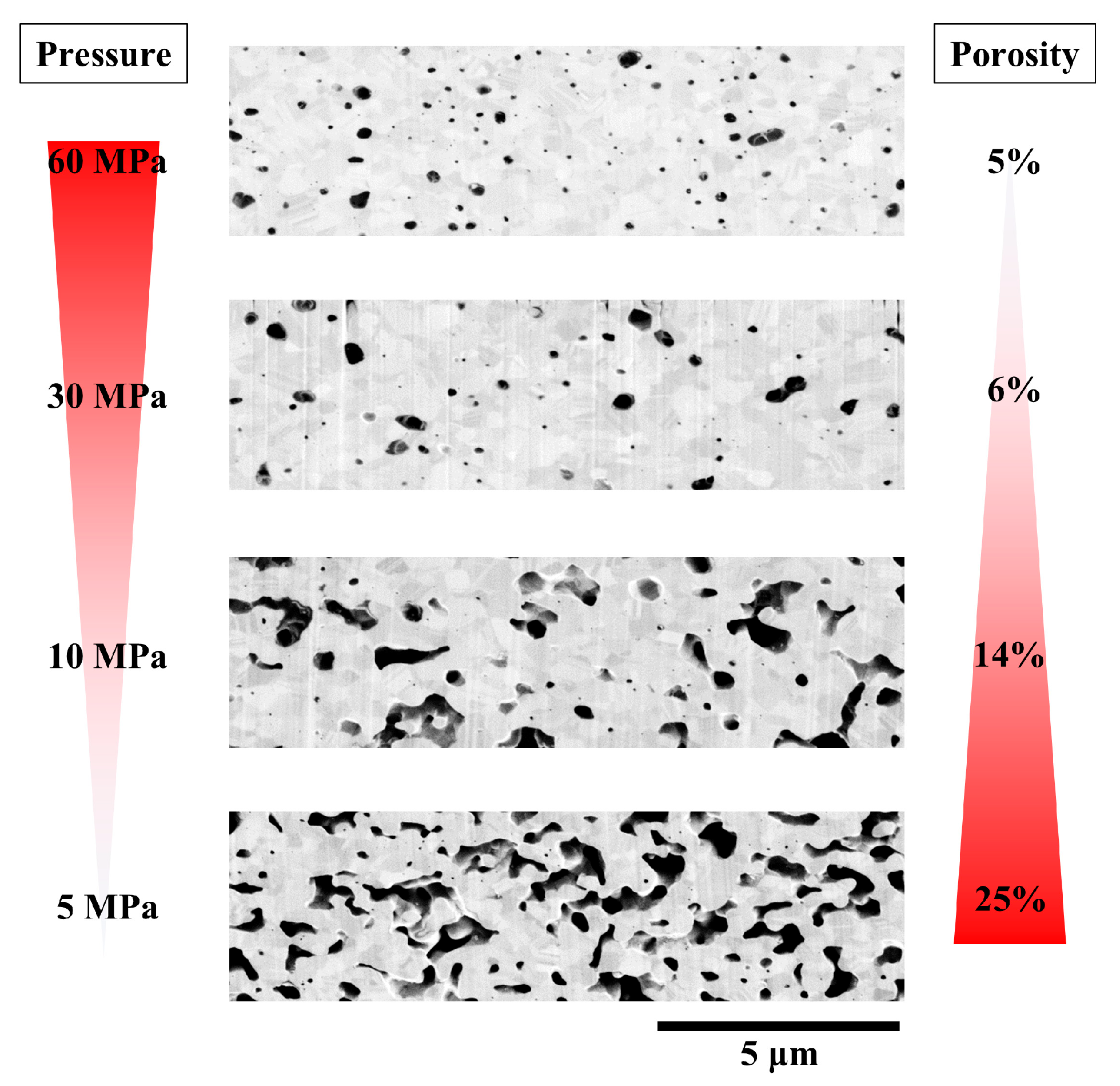

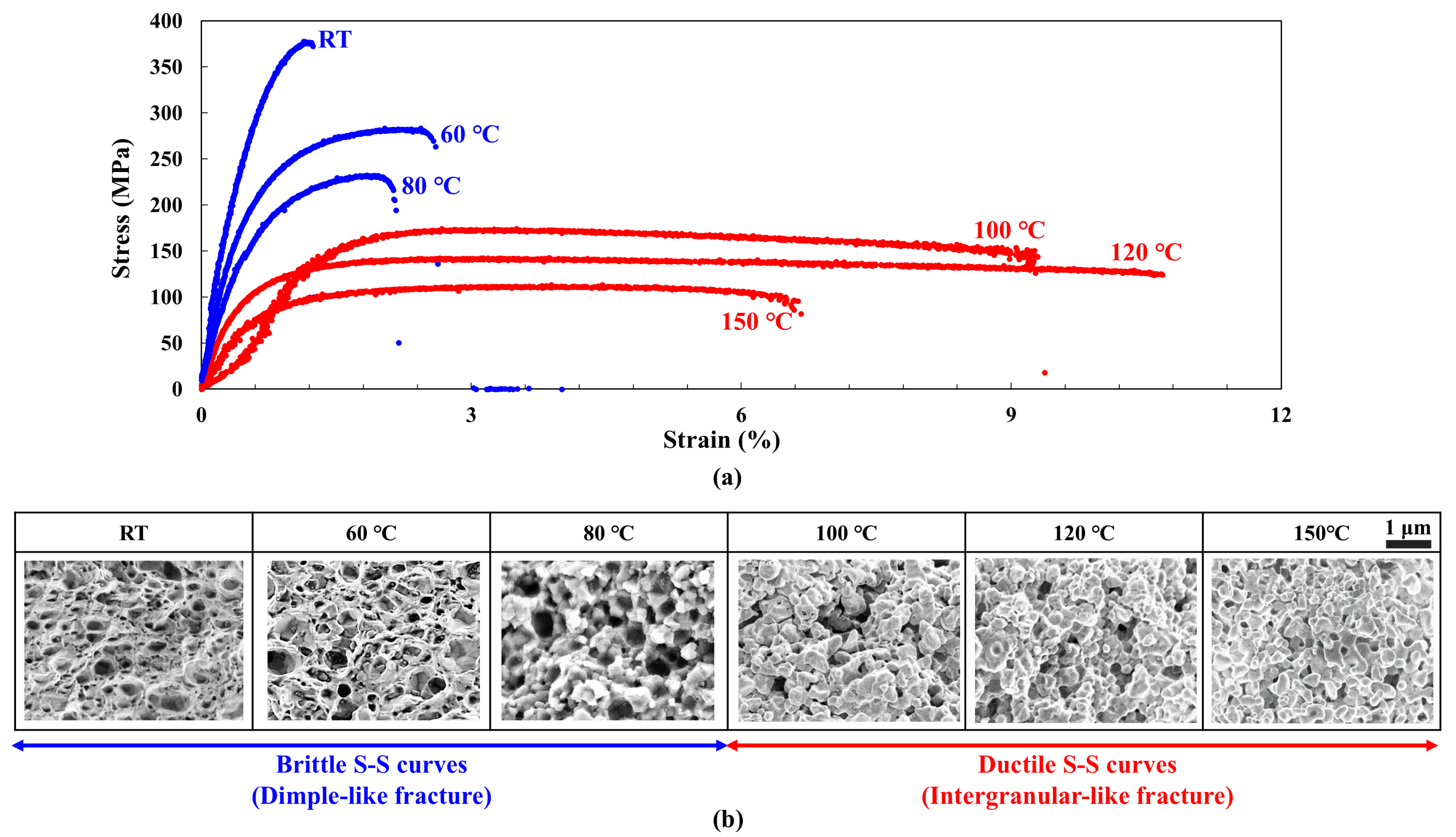
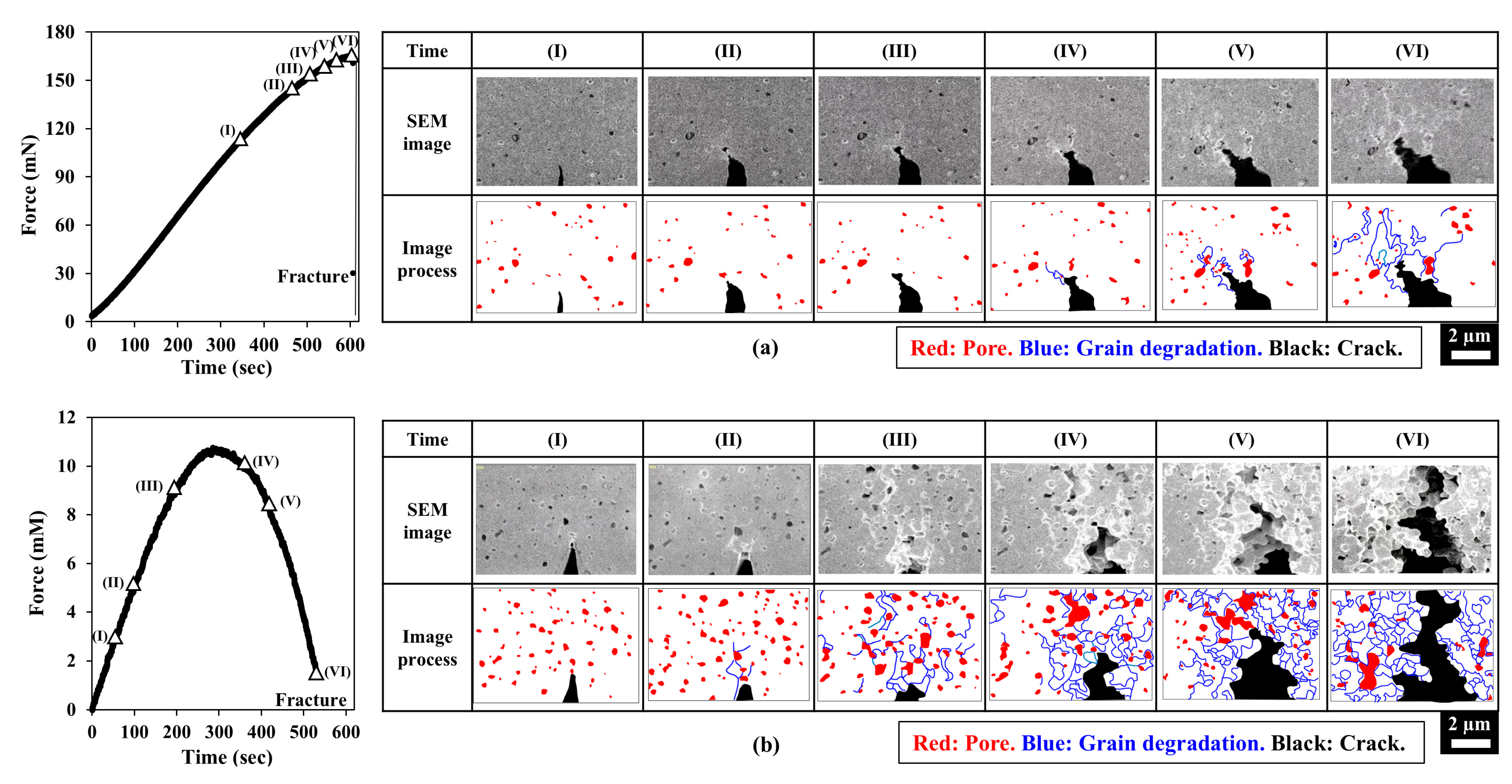
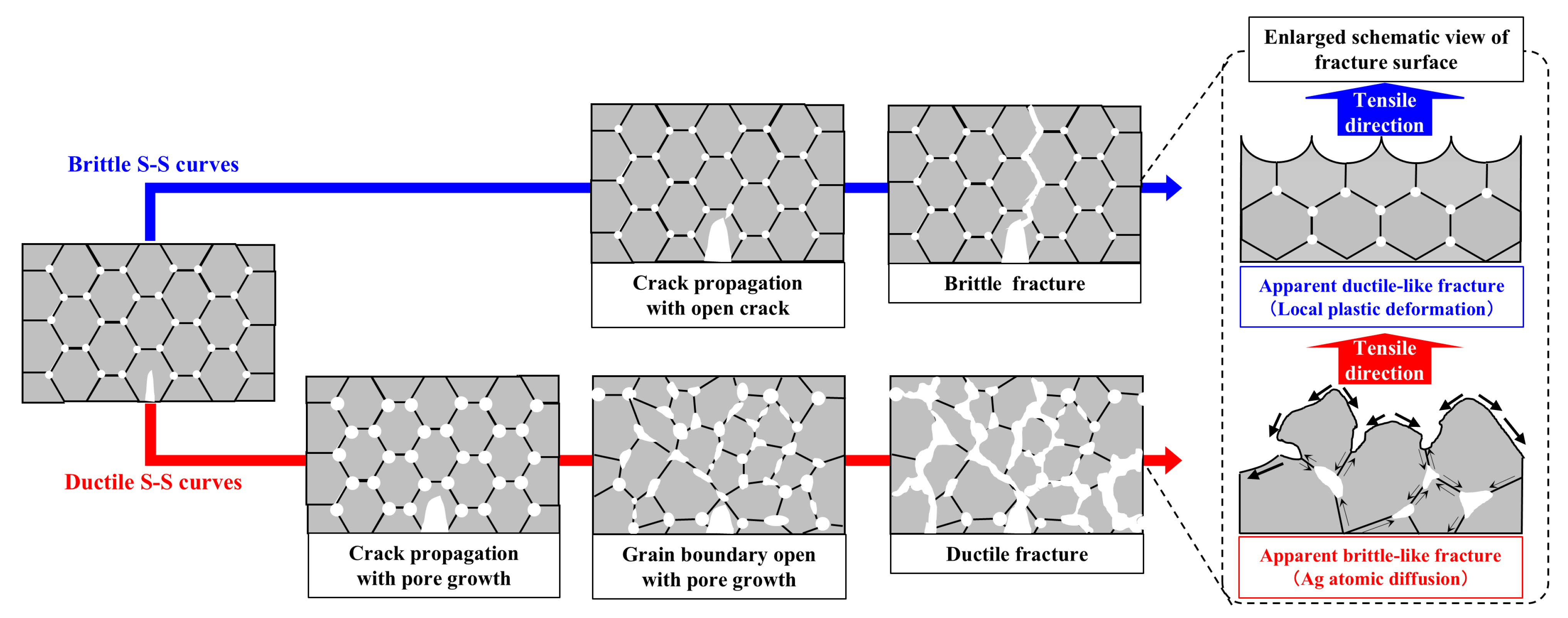


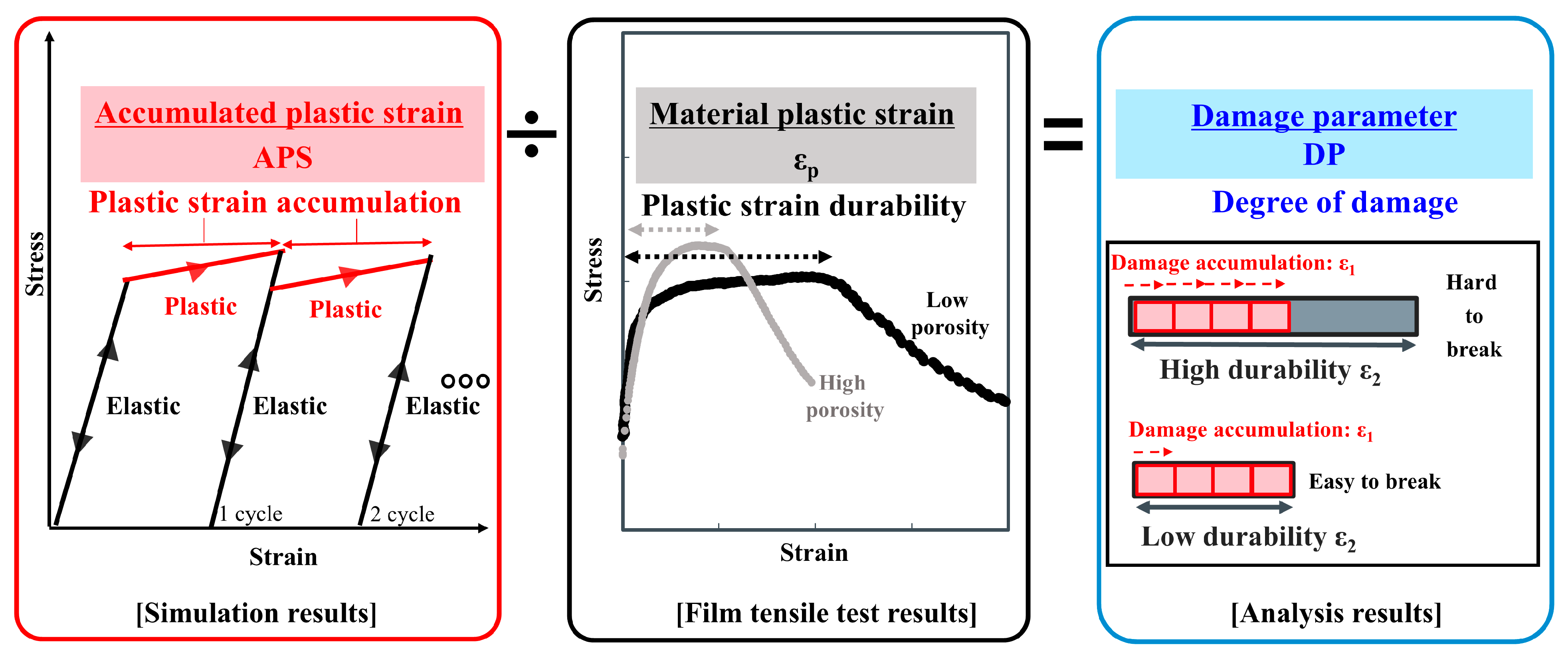

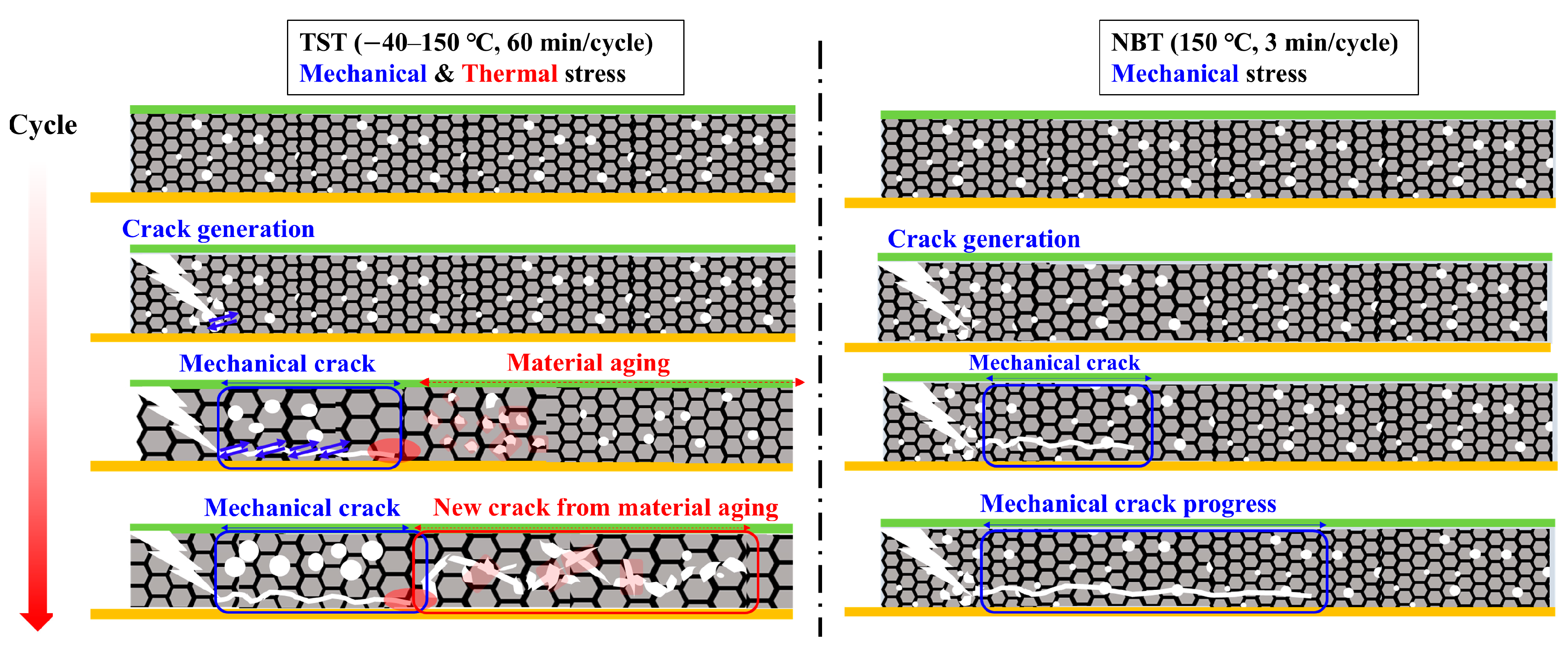
Disclaimer/Publisher’s Note: The statements, opinions and data contained in all publications are solely those of the individual author(s) and contributor(s) and not of MDPI and/or the editor(s). MDPI and/or the editor(s) disclaim responsibility for any injury to people or property resulting from any ideas, methods, instructions or products referred to in the content. |
© 2024 by the authors. Licensee MDPI, Basel, Switzerland. This article is an open access article distributed under the terms and conditions of the Creative Commons Attribution (CC BY) license (https://creativecommons.org/licenses/by/4.0/).
Share and Cite
Wakamoto, K.; Namazu, T. Mechanical Characterization of Sintered Silver Materials for Power Device Packaging: A Review. Energies 2024, 17, 4105. https://doi.org/10.3390/en17164105
Wakamoto K, Namazu T. Mechanical Characterization of Sintered Silver Materials for Power Device Packaging: A Review. Energies. 2024; 17(16):4105. https://doi.org/10.3390/en17164105
Chicago/Turabian StyleWakamoto, Keisuke, and Takahiro Namazu. 2024. "Mechanical Characterization of Sintered Silver Materials for Power Device Packaging: A Review" Energies 17, no. 16: 4105. https://doi.org/10.3390/en17164105




